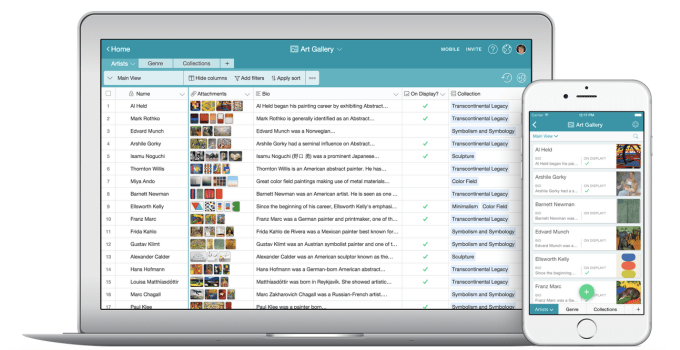
Two months after launching its unique organizational tool, Airtable is rolling out two new features that’ll make it easier to share your personal spreadsheet/database hybrids with others in a way they’ll find useful.
In addition to sharing direct read or edit access to the relational databases you create in its app, Airtable is today letting you draw from the underlying data using a powerful API, so you can embed that information in an application or website in a way that seamlessly blends into the experience. If that’s a bit outside your skillset, Airtable is also rolling out the ability to share your data as an embed that you can customize and share as simply as you would a YouTube video.
For those unfamiliar with the startup, Airtable’s app makes it easy to handle the non-calculation tasks people sometimes jam into Excel — organizing lists of participants in an event, links to relevant materials for a project, or a list of restaurants in your area you think would be nice to try, organized by price or style.
Instead of just making it easier to put together rows and columns of arbitrary text and numbers on your phone, Airtable put a relational database behind the scenes so your information can be logically linked together to provide a broader organizational structure.
Professionally, a team might use it to replace a legacy CRM so everyone can keep track of their leads without using an app that somehow managed to forget the design lessons of the last decade (you know what I’m talking about, person who has used any CRM application ever). Or a production studio might use it to keep everyone on the same page for shooting schedules, combing lists of crew, cast members, locations, props and scenes into something cohesive.
In a visit to TechCrunch earlier this week, Airtable co-founder Howie Liu also showed me how he’s been using it for personal organization. In a similar fashion to the movie production use case, Liu organized a camping trip, tying together the people going, groups going in different cars, and who was bringing which supplies.
Liu used this example to demonstrate the new embed system. While the list of camping supplies was created for a specific trip, the supplies themselves are useful for a wide variety of outdoors-y situations. So maybe you want to share that list on your blog as recommendations for others — you could open up Airtable, bring up the embed interface, cut out irrelevant data, and have an embed code ready in fewer than 30 seconds.
Airtable is hoping that people will adopt the app for themselves, and then bring it to their workplace, and vice-versa. To promote such adoption, the startup watches for users coming up with neat ways to use the app, and when it finds something that could be used broadly, adapts the custom solutions made by users into templates that others can build from.
Liu says he wants the template options to one day evolve into something resembling an app store, with Airtable itself getting out of the way but enabling customization for power users willing to dig in to its features and integration with other services.